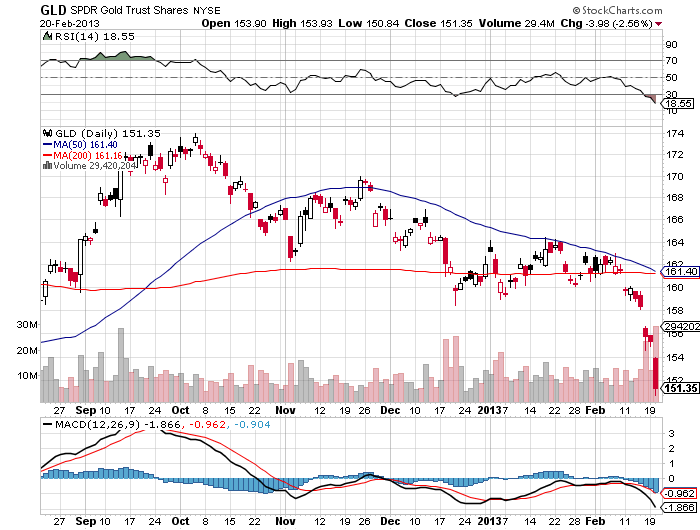
Commodities / Gold and Silver 2013
Feb 21, 2013 - 03:40 PM GMT By: Money_Morning

 Jeff Uscher writes: There are a lot of moving parts to the gold story so let's start with the biggest takeaway: Gold prices are facing only a temporary setback.
Jeff Uscher writes: There are a lot of moving parts to the gold story so let's start with the biggest takeaway: Gold prices are facing only a temporary setback.
Longer-term, as the U.S. Federal Reserve and other central banks begin to wind down quantitative easing and, more importantly, begin to ease interest rates back up to more "normal" levels, inflation should begin to kick in and drive gold up to new highs, making the yellow metal a great long-term investment.
First, though, let's tease apart the various factors that currently are driving the price of gold lower.
QE and Gold Prices
The Federal Open Market Committee is beginning to consider the timing of the end of quantitative easing.
The most recent FOMC meeting explored the idea of ending quantitative easing but keeping the Fed funds rate between zero and 0.25% until unemployment falls below 6.5% and as long as inflation remains below 2.5%.
But the markets are expecting long-term rates to rise when the Fed stops buying Treasury bonds through its asset-purchasing (quantitative easing) program.
The market is assuming that the Fed's purchases are keeping long-term interest rates artificially low.
Once those purchases stop, it is reasoned that long-term rates will rise to where they would be if the Fed had done nothing. As a result, the yield curve has steepened with 10-year rates now over 2.0% and 30-year bonds yielding 3.19%.
Although the yield curve has steepened, it is not really discounting any inflationary expectations. That is especially true, given the looming budget sequester next week.
Yields on 10-year Treasury Inflation-Protected Securities (TIPS) are still negative while 30-year TIPS offer a whopping 0.6% annual, inflation-adjusted yield.
Perhaps gold prices are telling us that since the market is not anticipating inflation for the next 30 years, there is no real point in owning gold as an inflation hedge.
Check Out this Ugly Gold Prices Chart
Although the gold chart is more of a symptom than a cause, gold has broken below just about all of its major supports on the daily chart.
You can also look at the SPDR Gold Trust (NYSE: GLD). GLD's price has fallen below its 500-day simple moving average for the first time since Oct. 22, 2008, at the height of the financial crisis. GLD traded below the 500-day simple moving average until Dec. 9, 2008, and never touched that moving average again until Feb. 11, 2013.

Much has been made of the fact that, in the next day or two, GLD's 50-day simple moving average and the 200-day simple moving average will form a death cross (when the 50-day moving average crosses below the 200-day moving average and both are moving lower) but this is simply a confirmation that GLD is in a down trend. That has been evident since the 50-day simple moving average peaked back on Nov. 23, 2012.
What's more important is that there's support for GLD around the 150 level, which held twice during 2012. If that fails, then the next support level would be at the 200-week simple moving average, currently 137.46 and rising.
The chart is ugly to be sure, but it isn't game-over for GLD.
Unusual Moves in the Gold Futures Market
Perhaps the most likely cause of the recent weakness in gold prices comes from the unusual relationship between the spot gold price and gold futures.
When traders buy gold futures, unless they want to take delivery of physical gold, they must sell expiring futures contracts and roll their positions out to a later month.
Typically, as a near contract approaches expiry, it will trade at a discount to the spot price as selling reaches a climax. This is happening right now to the February contract and there is nothing unusual about that.
What is unusual is that the April contract, where there is no pressure from expiration, went into backwardation Friday. This means that you can make a profit by selling spot gold today and buying a contract to receive delivery of gold in April.
But, according to Keith Weiner, writing for Monetary Metals LLC, what is really strange about this is that the open interest in the April gold contract is rising, which should be pushing the price of the April contract higher.
Weiner suggests that there is a large long silver/short gold arbitrage position out there. If that is true, the arb is getting killed as the gold/silver ratio has risen by 4.3% since the end of January.
In other words, as fast as the gold price has fallen, silver has fallen even faster.
When to Buy Gold
We remain positive on the long-term outlook for gold prices.
As mentioned above, higher long-term bond yields and the end of QE will not necessarily result in inflation.
Even though it sounds counterintuitive, inflation is being held in check by zero interest rates. Once the Fed starts to raise interest rates back toward "normal" levels, that's when we will begin to see the inflationary impact of all the QE that has been dumped into the market.
In the absence of inflation, we turn to the chart. There is strong support for GLD around $150. That seems to be a good entry point for a long-term rally in gold prices.
Gold prices were trading at $1,567.50 an ounce in New York Wednesday afternoon.
Check out our 2013 Guide to Investing in Gold.
Want to know more about gold prices and how to profit from them in 2013? Bill Patalon frequently updates his readers on how to play to gold in his Private Briefing investment service. Find out how to get in the loop here.
Source :http://moneymorning.com/2013/02/20/gold-prices-the-yellow-metals-still-a-great-long-term-investment/
Money Morning/The Money Map Report
?2013 Monument Street Publishing. All Rights Reserved. Protected by copyright laws of the United States and international treaties. Any reproduction, copying, or redistribution (electronic or otherwise, including on the world wide web), of content from this website, in whole or in part, is strictly prohibited without the express written permission of Monument Street Publishing. 105 West Monument Street, Baltimore MD 21201, Email: customerservice@moneymorning.com
Disclaimer: Nothing published by Money Morning should be considered personalized investment advice. Although our employees may answer your general customer service questions, they are not licensed under securities laws to address your particular investment situation. No communication by our employees to you should be deemed as personalized investent advice. We expressly forbid our writers from having a financial interest in any security recommended to our readers. All of our employees and agents must wait 24 hours after on-line publication, or after the mailing of printed-only publication prior to following an initial recommendation. Any investments recommended by Money Morning should be made only after consulting with your investment advisor and only after reviewing the prospectus or financial statements of the company.
? 2005-2013 http://www.MarketOracle.co.uk - The Market Oracle is a FREE Daily Financial Markets Analysis & Forecasting online publication.
Source: http://www.marketoracle.co.uk/Article39126.html
lifehouse al gore la dodgers lawrence o donnell magic johnson jetblue pilot solicitor general
 Davidson Farmer?s Market is back again Saturday for the first of three winter tailgate markets during March, including an extra market added at the month?s end. Meanwhile, the dining calendar is busy in March, with wine dinners, beer tastings and live music at Ass Clown Brewery, a Russian food and music festival at Davidson College, and a big two-day St. Patrick?s Day celebration at Galway Hooker. Read on for the details.
Davidson Farmer?s Market is back again Saturday for the first of three winter tailgate markets during March, including an extra market added at the month?s end. Meanwhile, the dining calendar is busy in March, with wine dinners, beer tastings and live music at Ass Clown Brewery, a Russian food and music festival at Davidson College, and a big two-day St. Patrick?s Day celebration at Galway Hooker. Read on for the details.

 A bill to create an athletic commission in South Dakota is going nowhere fast, largely thanks to the ignorance of Gov. Dennis Daugaard and state house Rep. Steve Hickey.
A bill to create an athletic commission in South Dakota is going nowhere fast, largely thanks to the ignorance of Gov. Dennis Daugaard and state house Rep. Steve Hickey. The simple fact is that a random NFL player is at far greater risk of a serious brain injury than is a random MMA fighter. Sadly, neither Gov. Daugaard nor Rep. Hickey bothered to do much investigation or educate themselves before speaking out.
The simple fact is that a random NFL player is at far greater risk of a serious brain injury than is a random MMA fighter. Sadly, neither Gov. Daugaard nor Rep. Hickey bothered to do much investigation or educate themselves before speaking out. A fear of many states with strong commissions is that promoters will travel across state lines to put on shows in states such as South Dakota, where there is no regulation and where, as a result, costs are less. But the result is that it is far less safe for the competitors.
A fear of many states with strong commissions is that promoters will travel across state lines to put on shows in states such as South Dakota, where there is no regulation and where, as a result, costs are less. But the result is that it is far less safe for the competitors.



